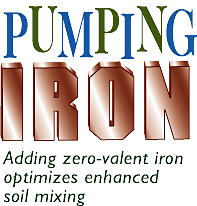


The low permeability of fine-grained soils like those rich in clay presents a special challenge to technologies designed to remediate soils contaminated with volatile organic compounds. In situ soil mixing of such soils offers an economical alternative to excavation and ex situ treatment. Researchers have experimented with various methods of enhancing the benefits of soil mixing.
The 1997–98 study was performed in an active hazardous and radioactive waste processing and storage area in the southern end of ANL’s 1,500-acre site. In the late 1950s, liquid waste was placed in a unit known as the French Drain. Since then, waste has migrated into underlying soil and ground water. A remedial feasibility investigation detected 11 VOCs at levels that required corrective action. All the study areas were treated using enhanced soil mixing, which reduced the VOC concentrations from over 300 parts per million (ppm) to less than 20 ppm. The soil ventilation system was deployed by installing two slotted vertical pipes into the mixed soil. A vacuum system attached to one of the pipes pulled air through the mixed soil to remove contaminants. The biodegradation experiment was initiated by injecting nutrients and methanol (a supplemental carbon source) into the treated area using the soil mixing equipment. In the iron addition experiment, a water slurry containing metallic iron particles (<0.3 mm in diameter) was injected into the soil with the soil mixing equipment. The effects of the three polishing systems on VOC concentrations were monitored for up to 90 days. The soil ventilation and biodegradation experiments produced no discernible effects on residual VOC concentrations levels. The poor results in the soil ventilation study are probably explained by the low permeability of the soil, compounded by the use of steam rather than hot air to enhance vapor extraction. Biodegradation might also have shown better results under different circumstances. Dosage of nutrients and methanol was based on experience rather than site-specific optimization studies, and the performance monitoring period may have been too short to detect the long-term effects of the biodegradation experiment. On the other hand, monitoring revealed that the addition of iron caused a significant reduction of residual chlorinated VOC concentrations. The process is a reductive dechlorination reaction. As the injected zero-valent iron is oxidized to iron oxides, chlorine atoms are removed from the VOCs, leaving behind harmless chloride ions in the soil and relatively innocuous gases that dissolve in ground water or escape to the surface. Within 10 days of the addition of iron, the residual concentrations of carbon tetrachloride, chloroform, and 1,2-dichloroethene decreased to below analytical detection limits (<0.10 ppm). Within 20 days, trichloroethene levels fell more than 85 percent. Nonchlorinated VOCs were not affected by the iron as much as the chlorinated VOCs. The ANL-E study indicated that, in certain soils, the use of zero-valent iron with enhanced soil mixing rapidly removes more of the contamination than soil mixing alone, for little additional cost, improving overall cost-effectiveness. Argonne, operated for DOE by the University of Chicago, has applied for a patent on the iron-addition process. For more information, contact Larry Moos, Technical Director, Argonne National Laboratory–East Remedial Actions Project, (630) 252-3455, lmoos@anl.gov. |